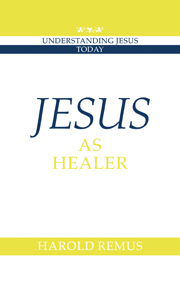Book contents
- Frontmatter
- Contents
- Preface
- 1 Jesus as Healer: Prologue
- 2 Jesus as Healer: The Gospel of Mark
- 3 Jesus as Healer: The Gospel of Matthew
- 4 Jesus as Healer: The Gospel of Luke
- 5 Jesus as Healer: The Gospel of John
- 6 Jesus as Healer: Apocryphal Writings
- 7 “In His Name”: Jesus Heals Through His Followers
- 8 Did Jesus Really Heal?
- Questions for further thought and discussion
- Suggestions for further reading
- Index of Subjects and Names
- Index of Ancient Writings
2 - Jesus as Healer: The Gospel of Mark
Published online by Cambridge University Press: 12 October 2018
- Frontmatter
- Contents
- Preface
- 1 Jesus as Healer: Prologue
- 2 Jesus as Healer: The Gospel of Mark
- 3 Jesus as Healer: The Gospel of Matthew
- 4 Jesus as Healer: The Gospel of Luke
- 5 Jesus as Healer: The Gospel of John
- 6 Jesus as Healer: Apocryphal Writings
- 7 “In His Name”: Jesus Heals Through His Followers
- 8 Did Jesus Really Heal?
- Questions for further thought and discussion
- Suggestions for further reading
- Index of Subjects and Names
- Index of Ancient Writings
Summary
The story of the healing of the hemorrhaging woman referred to several times in the preceding chapter is presented in greatest detail in the gospel thought by most scholars to be the first written, the Gospel of Mark. Chronological priority is one reason for beginning a study of Jesus as healer in early Christian writings with the Gospel of Mark. Whether or not it was indeed the first gospel (some scholars dispute that), there are other factors that recommend it as a starting point: its brevity, permitting a ready overview of the whole, and the fact that, in comparison with the other New Testament gospels, it devotes less space to Jesus as teacher and more to what he does, including a good number of healings. The author generally presents these in more detail and more graphically than do the other evangelists. Once one has some understanding of Jesus as healer in Mark, then in subsequent chapters comparisons can more readily be drawn with the other three New Testament gospels.
Jesus as healer
The healing stories, along with other miracle accounts, make up much of the first nine chapters of the Gospel of Mark. There emerges a Jesus who fulfills John the Baptist's proclamation that one mightier than he is yet to come (1:7): the miracles signal that the reign of God that Jesus has announced is near at hand (1:15). In the power of the Spirit that has descended on him at his baptism (1:10), Jesus, through these displays of power, demonstrates that God's reign is unfolding. He wondrously feeds multitudes of hungry people (6:30-44; 8:1-9), walks on water and stills wind and wave (6:45-51), and causes a fig tree to wither to its roots (11:14, 20-21). These wonders are outnumbered, however - indeed, overshadowed, one might say - by the many accounts of healings and expulsions of demons that occur in every one of the first ten chapters except chapter four, a collection of parables.
In several places the evangelist simply uses general terms or idioms to designate the many who come to Jesus for healing.
- Type
- Chapter
- Information
- Jesus as Healer , pp. 13 - 39Publisher: Cambridge University PressPrint publication year: 1997

